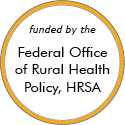South Dakota Models and Innovations
These stories feature model programs and successful rural projects that can serve as a source of ideas. Some of the projects or programs may no longer be active. Read about the criteria and evidence-base for programs included.
Effective Examples
Care for Our Elders/Wakanki Ewastepikte
Updated/reviewed June 2023
- Need: To provide Lakota elders with tools and opportunities for advance care planning.
- Intervention: An outreach program in South Dakota helps Lakota elders with advance care planning and wills by providing bilingual brochures and advance directive coaches.
- Results: Care for Our Elders saw an increase in the number of Lakota elders understanding the differences between a will and a living will and the need to have end-of-life discussions with family and healthcare providers.
Promising Examples
SD eResidential Facilities Healthcare Services Access Project

Updated/reviewed August 2020
- Need: To increase local health services to rural elderly populations in long-term care facilities located in four Midwest states near a tertiary care organization.
- Intervention: A non-profit healthcare organization implemented telehealth services to provide acute care evaluations for long-term residents in their home facilities.
- Results: The program increased local care as evidenced by improved year-over-year provider-determined available transfer data: 33%, 50%, 63% program years 1 through 3, respectively. From the success of the initial pilot implementation, the program has further matured into a long-term care offering that now reaches many other rural facilities located in 10 states across the nation.
The Rural Virtual Infusion Program

Updated/reviewed April 2020
- Need: Allow rural cancer patients in a region inclusive of 26 counties in Iowa, Minnesota, and South Dakota to have access to tertiary-level chemotherapy regimens in rural infusion centers.
- Intervention: With telehealth-based oversight from a tertiary care oncology team, 3 rural infusion teams were trained to coordinate cancer treatment plans and administer complex chemotherapy regimens.
- Results: Almost 130 patients were transitioned to receive chemotherapy in a rural infusion center, translating to over 1,000 infusion visits and saving patients/families nearly 65,000 trip miles, 1,800 travel hours and $71,000.
Other Project Examples
Rural Aging Action Network
Updated/reviewed January 2024
- Need: To connect underserved and isolated older adults in rural Minnesota, Montana, North Dakota, and South Dakota to services and supports so they can age in place.
- Intervention: The Rural Aging Action Network is a collaborative of organizations that offer different services like caregiver support, behavioral health, financial counseling, and assistance with chores and household maintenance.
- Results: Since 2015, the collaborative has reached over 4,000 older adults and caregivers in over 100 rural communities.
Safe Place of Eastern South Dakota
Updated/reviewed November 2023
- Need: To provide victims of domestic violence and sexual assault a safe space, advocacy, education, and family support services.
- Intervention: Safe Place of Eastern South Dakota provides emergency/transitional housing, support and referral services, family visitation services, and community education.
- Results: In 2022, Safe Place of Eastern South Dakota answered 350 crisis calls, provided shelter for 132 survivors, and advocated for 94 survivors.
Rural Experiences for Health Professions Students (REHPS)

Updated/reviewed July 2023
- Need: An ongoing shortage of healthcare providers in rural areas of South Dakota
- Intervention: A 4-week summer program placing health professions students in rural communities.
- Results: Of graduating participants, 71% practice in South Dakota with 30% of those graduates practicing in rural communities with populations fewer than 10,000, or veteran facilities.
Facing Diabetes: Quality Improvement in Rural South Dakota Project

Updated/reviewed May 2023
- Need: To help adults and children in rural South Dakota prevent or manage their diabetes.
- Intervention: The Facing Diabetes Project offered medical visits for adults and provided prevention and education sessions for the local 4th and 5th graders.
- Results: Many adults and children in the region felt better equipped to choose healthy foods, exercise regularly, and manage their stress: all factors that can help prevent diabetes or decrease its effects.
South Dakota Harvest of the Month Program
Updated/reviewed May 2023
- Need: To encourage children to make healthy eating choices through learning and tasting.
- Intervention: Brief, fun, and informative presentations and tastings for children on over 42 different fruits and vegetables.
- Results: Participants are exposed to new foods and show more interest in healthy eating.
Delta Dental Mobile Program
Updated/reviewed March 2023
- Need: Lack of access to oral healthcare for children from limited-income families in the rural and urban areas of South Dakota.
- Intervention: Delta Dental of South Dakota launched the Delta Dental Mobile Program in 2004 to expand access to oral healthcare services to children throughout the rural state.
- Results: The Delta Dental Mobile Program has provided over $38 million in dental care to more than 68,000 South Dakota children.
Simulation in Motion-South Dakota (SIM-SD) EMS Educational Outreach Program
Updated/reviewed February 2023
- Need: To provide increased educational opportunities for emergency care personnel in rural and frontier South Dakota.
- Intervention: A technologically advanced training was created to enhance the delivery of emergency patient care.
- Results: Hundreds of emergency medical services (EMS) staff and volunteers received training that in turn helped them in the field of emergency patient care.
Last Updated: 1/3/2024

